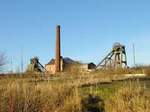
Section under development
North pit shaft guides
When the North shaft was sunk it was fitted up with wooden guides for the cages. Working three shifts of eight hours for seven days a week this took three months to complete and cost £1,722 (1877 prices) excluding the cost of fixing the wall-boxes which carried the oak cross-stays. Initially, Oregon pine was tried for the guide rails but it was found to be unsatisfactory and was replaced by pitch-pine.
After the installation of steel guide rails in the South shaft following its deepening in 1922, thoughts began to turn to replacing the North shaft guides with the same type but with the deteriorating situation in the coal mining industry in the 1920s and 30s, this was put on hold. It was not until the late 1940s when the post-nationalisation modernisation program took place that the change was finally made, this time with the cages fitted up with a single pair of rails at the shaft side.
1877 - 1950
- type wooden rails
- number 4 per cage (2 each side)
- material Oregon-pine then pitch-pine
- size 4.75in x 4.25in (12cm x 10.8cm)
Cross-stays (byatts/buntons)
- number 1 central, 2 outer
- material oak
- size
- central: 9in x 8in x 16.5ft
- (23cm x 20cm x 5m)
- outer: 9in x 6in x 14ft
- (23cm x 15cm x 4.4m)
- separation 10ft (3m)
- fixing
- brackets cast on tubbing
- cast-iron boxes in brickwork
1950 - closure
- type bull nose rails
- number 2 per cage on outside
- material steel
- size ??
- length 36ft (11m)
- number 1 each side of shaft
- material ? RSJ
- size
- outer: ? 9in x 6in x 14ft
- (23cm x 15cm x 4.4m)
- separation ? 10ft (3m)
- fixing
- brackets cast on tubbing
- cast-iron boxes in brickwork
Cross-stays (byatts/buntons)
South pit shaft guides
In 1888 the South shaft was upgraded to allow coal winding. Twin-deck cages with two 1.125in (2.29cm) diameter guide ropes on each side were installed. When the new headstock was installed and the South shaft infrastructure upgraded in 1900 the guide ropes were re-arranged to give three 1.5in (3.8cm) diameter guide ropes on the outside of each cage and two 2in (5cm) diameter rubbing ropes between the cages, each of which were fitted with oak rubbing boards. Due to the wetness of the shaft the lifetime of the ropes was only about 5 years rather than the 12 - 15 years normally obtained in a dry shaft.
The ropes were suspended from the headframe by clamping to short stub ropes or bars. It had been found that most guide rope fatigue occurred near to the suspension points and so the ropes were shortened at regular intervals by pulling a few feet up through the suspension clamps. The excess rope was left dangling until the rope itself was renewed.
At the top of the shaft, the cages engaged with short wooden receiver guides which positioned it in line with the tub-rails. A fragment of one of these guides is still in place in the South headframe.


Guide rope suspension system on the South pit headstock. 1900 - 1920 (FoPP/JST)
Remains of a wooden cage decking -guide in the South pit headstock. 1900 - 19??
When the South shaft was deepened in 1922 the distance was considered too great for guide ropes and these were replaced with steel rails fastened to buntons across the center of the shaft. The buntons consisted of a pair of steel channel irons mounted horizontally back-to-back and were inserted into holes made in the shaft brickwork. What was done in the section which had the tubbing is uncertain, but would probably involve support brackets bolted to the tubbing itself. Long steel plates were bolted to the sides of the channels and the rails were secured to these by steel clamping bars.
The cages were attached to the guide rails by steel slippers at each corner. Unlike the photos below which were taken during salvage operations after closure, the rails and slippers were kept well greased.

South pit guide-rail attachment arrangement. (FoPP/JST)

South pit guide-rail with cage slipper. (FoPP/JST)
1879 -1888
- unknown
1888 - 1900
- type rope
- number 4 per cage
- material iron
- size 1.5in (3.8cm) dia
- hangers ??
- tension ? cheese weights in sump
1900-1919
- type rope
- number
- 3 on outer side of cage
- 2 central rubbing ropes
- material iron ? steel
- size
- 1.5in (3.8cm) dia for cage
- 2in (5cm) dia for rubbing
- hangers clamped to stub rod/rope
- tension cheese weights in sump
1922 - closure
- type bull nose rails
- number 2 per cage on inside
- material steel
- length 36ft (11m)
- size 5in base : 4in x 2in nose
- (37cm : 10cmx 51cm)
Cross-stays (byatts/buntons)
- type composite:
- 2 x horizontal channel-iron
- number 1 central
- material steel
- size 2 @ 8in x 4in (20cm x 10cm)
- length
- 16ft (4.9m) at brickwork
- 14.5ft (4.4m) at tubbing
- weight approx 0.5 ton (0.51 tonne)
- separation ? 10ft (3m)
- fixing
- fixed in brickwork
- bracket on tubbing
Sources
- J.C.B Hendry Trans Inst Min Eng 1891
- G.A.L. Longden Trans Inst Min Eng 1901
- Mr Allen Hill’s personal record book (Shaftsman)
Copyright © 2023 J S. Thatcher
Page updated on:
11 Nov, 2023
at
05:24:42 PM
In case of problems contact: